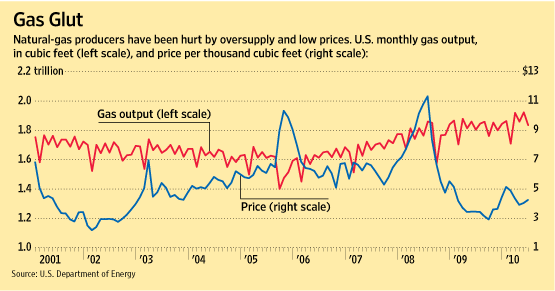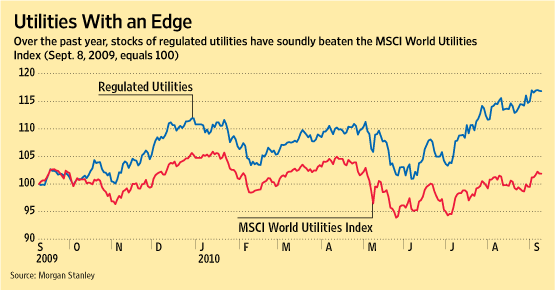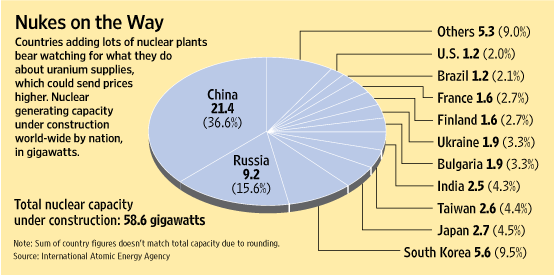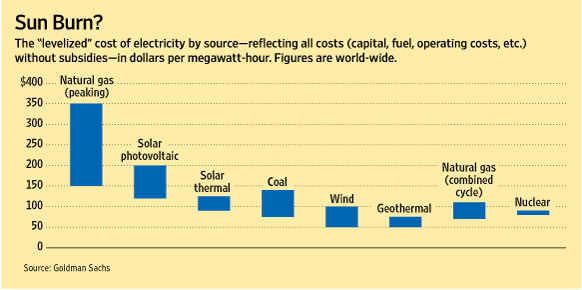The Wall Street Journal claims that there is a lot of money to made (and lost) through investments in the energy sector and provides a quick overview of background information it thinks investors need to know [“Power Investing,” by Liam Denning, 13 September 2010]. Denning writes:
“For investors, the energy business used to be a pretty simple play: Buy a stock and stick with it. Until a couple of years ago, soaring oil and natural-gas prices made any energy bet pay off. Not only did oil and gas stocks rise, but so did alternative-energy shares: With fossil fuels getting pricier, solar and wind power looked much more competitive. Then came the crash of 2008, and all that went out the window. These days, the energy sector is about as complicated as it gets, with a range of issues buffeting stock prices and making it tough to know where to put your money—and when to do it. Not only is the economy playing havoc with demand and energy policy world-wide, but individual industries are facing complex challenges with very uncertain outcomes. Oil and gas producers, for instance, are grappling with the aftershocks of the BP PLC oil spill, at the same time they’re facing a massive glut of natural gas that’s driving down the price of the fuel. And alternative-energy companies in the U.S. are stuck in limbo. They were pinning their hopes on ambitious climate legislation to make fossil fuels more expensive—but the bill stalled and likely won’t be back on the table anytime soon. Overseas, governments are slashing the subsidies that alternative suppliers desperately need. Still, there’s money to be made in the energy business—if you know where to look.”
To help make sense of the energy sector, Denning parses it into segments beginning with oil and gas. He continues:
“When it comes to oil and natural gas, it’s hard to ignore the elephant in the room: Many companies in this sector have been thrown for a loop by the spill in the Gulf of Mexico, and the effects of the disaster are likely to linger. Stephen Richardson, an analyst at Morgan Stanley, sees increased costs for oil and gas producers as regulations tighten, which could hurt profit margins and even force some smaller companies to exit high-risk offshore projects. What should investors watch for? Federal officials have hinted at an early end to the deepwater-drilling moratorium, due to run until Nov. 30. If that comes to pass—something that’s by no means certain—it could be a hopeful sign for drillers. Beyond this, investors will have to wait for the results of continuing investigations into the disaster and how to prevent future ones. … Another near-term factor to watch out for is further merger activity, which could potentially drive up stock prices. There has been a spate of deals involving larger companies buying smaller gas producers. Last December, Exxon Mobil Corp. agreed to buy XTO Energy Inc. for $31 billion, the oil major’s biggest deal in a decade. Still, there’s an even bigger issue facing the industry than the Gulf spill: oversupply. Oil and gas producers have adopted and refined advanced drilling techniques enabling them to tap unconventional resources such as shale gas, trapped in dense rock thousands of feet underground. U.S. natural-gas reserves and production, after years of decline, are now back to levels last seen in the early 1970s. Meanwhile, U.S. gas consumption peaked in 2000 and fell 2% in 2009, as the recession damped demand.”

To learn more about the future of natural gas, read my post entitled On the Cusp of the Natural Gas Era. Denning notes that natural gas prices have tumbled nearly 30% over the past three years, primarily due to an oversupply of natural gas. Nobody knows exactly what the future holds for natural gas sector once the oversupply ends. Denning continues:
“Low prices would usually spur producers to stop drilling and help rebalance the market, but that isn’t happening for a variety of reasons, including lease conditions and the sector’s natural bias toward growth. … If all this suggests avoiding the sector, Jonathan Waghorn, co-head of Investec’s Global Energy Fund, posits a contrarian view. ‘Gas is hated’ by investors, he says, which could present a buying opportunity for those willing to ride out near-term weakness. Mr. Waghorn argues that producers with the highest costs need a gas price of about $4 per million British thermal units to keep running. Today, the average gas price in the futures market for 2011 is about $4.70 per million BTUs. But developing new shale resources, which will be needed in the future, requires a much higher price—$6 or more per million BTUs—to deliver a suitable return on producers’ investment. If developers don’t think they can get that price, they won’t go ahead with new gas projects—which will limit new supply, tighten the market and cause the gas price to rise.”
As I noted the post I just mentioned, some analysts don’t believe that shale gas will be profitable until the price reaches $10 per million BTUs. Denning notes that if the global economy continues to sputter, oil prices might also fall. As a result, he concludes: “Investors should look for signs that demand for gas is recovering and that inventories of the fuel, currently very high, are declining.” The wild card in the oil and gas sector is the future of “comprehensive climate-change legislation, including effective limits on carbon emissions.” If the legislation passes, which doesn’t look very likely in the current political climate, it “could help redress the imbalance of natural-gas supply and demand. Gas emits about half as much carbon as coal when burned, so putting a cost on carbon would make gas more competitive versus coal. Gas demand would likely rise.” Denning next turns to the utilities sector, where coal remains king. He writes:
“Gas and government loom large in the outlook for electricity producers, too. Gas-fired plants provide 23% of America’s power, and in much of the country set the market price for electricity. So, higher gas prices often mean higher profit margins for suppliers that own coal, nuclear or hydropower plants. Their fuel costs are often lower than those of suppliers relying on gas-fired plants, but market prices for electricity are still tied to the price of gas. Like the gas producers, utilities have been hoping an economic rebound would fire up demand for energy. Further help was supposed to come from Washington in the form of comprehensive climate-change legislation. The hope was that by making carbon-intensive fuels like coal more expensive, the new rules would force many such power plants to shut down and tighten electrical capacity—raising prices and profits. But a lack of legislation and slack demand has complicated that picture. Indeed, analysts at Barclays Capital believe demand for electricity will not return to prerecession levels for some years yet, weighing on prices.”
Denning asserts that the best place to invest in the utilities sector over next few years is with “regulated utilities, which have their rates set periodically by state officials with the aim of allowing the utilities to make a decent return on their investment.” He continues:
“Over the past year, regulated-utility stocks have risen 17%, compared with just a 2% rise for the MSCI World Utilities Index overall. Driving the growth: low gas prices and Treasury yields. Low fuel costs keep prices down and regulators happy. Low yields, meanwhile, make regulated utilities’ dividends attractive to investors. Neil Wynne at Sanford C. Bernstein calculates that over the past 40 years, regulated utilities have on average beaten the S&P 500 during 12-month periods of falling inflation, such as we have now. He writes that the evidence suggests strongly that ‘utilities would function well as defensive investments in the event of further disinflation or eventual deflation.’ So, keeping an eye on where the consumer price index is going could help investors decide which utility stocks to buy and sell. … A caveat: Should tax rates on dividends rise substantially at the end of the year, it could hurt regulated-utility stocks. That said, Credit Suisse analyst Dan Eggers argues that if you compare the stocks’ dividend yields with bond and Treasury yields, the sector already is pricing in a reset in the tax rate to more than 30% from today’s 15%.”

The sector to which Denning next turns is nuclear power. He writes that there is “renewed interest” in nuclear power “thanks in large part to one simple fact: Nuclear plants do not emit carbon dioxide.” Despite the enormous investment it takes to build a nuclear plant, Denning reports that “some 60 nuclear reactors are under construction around the world.” He continues:
“Investing directly in nuclear power’s renaissance is not straightforward, however. Utilities that own nuclear plants often hold a variety of other types as well, which dilutes your exposure. Likewise, construction and engineering firms that build new plants do not focus just on the nuclear-power sector. Then there’s timing. Nuclear plants take many years to construct, in part because of high regulatory hurdles but also the costs involved, with Standard & Poor’s putting the average bill at upward of $7.5 billion. There are some nearer-term opportunities. ‘The real way to play nuclear right now is mining,’ says Ben Elias, an analyst at Sterne Agee. Uranium prices joined in the commodities bubble of a few years ago, hitting nearly $140 per pound in 2007, according to Ux Consulting Co. Today, the price is about $47. Mr. Elias says this price reflects the fact that utilities, the main buyers, have big stockpiles right now. Looking ahead, he sees the uranium market tightening as China and India, which account for almost half the world’s nuclear plants under construction, come to market to secure supplies. Canadian miner Cameco Corp., for example, plans to double its uranium output by 2018. In the near term, investors should watch for any news out of China or India that they are signing long-term supply contracts for uranium, which could be a sign that the market is about to heat up. And while new nuclear-power plants can take a decade to be approved and built, there is money to be made in the meantime refitting old stations to increase their output. Since the start of 2000, the NRC has approved 82 of these so-called uprates. Shaw Group Inc., which provides uprating services for nuclear plants, estimates the domestic market alone at $25 billion in revenue.”

One thing that Denning didn’t mention is that, if serious efforts are ever made to convert to a hydrogen economy, nuclear power will probably become one of the most cost-efficient ways to supply the energy needed to generate the pure hydrogen needed as fuel. Frankly, however, most scientists believe that a hydrogen-based economy is currently over the visible horizon. To read more about the future of nuclear power, read my post entitled Updates on Alternative Energy Sources, Part 2: Nuclear Power. Next Denning turns to wind power.
“In keeping with its name, the outlook for the wind-power industry seems ‘up in the air,’ says Geoff Styles, who runs energy consultancy GSW Strategy Group, based in Vienna, VA. Wind-power stocks surged along with the rest of renewables from 2006 into 2008, and then crashed with the broader market in late 2008—and have suffered since. So far this year, the sector is down 19%. What’s going on? The credit crunch has raised financing costs and made it difficult to justify building new wind farms in the U.S. and Europe. Weak demand for electricity also means fewer turbines are needed to meet renewable-energy targets. Another big factor: U.S. political commitment to reining in carbon emissions has wavered. A comprehensive energy bill would have made renewable-energy technologies more competitive as the price of electricity produced from fossil fuels like coal increased. This now looks unlikely, ‘at least until next year,’ says Mr. Styles. Meanwhile, in a recent note to clients, Jason Mitchell, a manager at hedge fund GLG Partners, says a ‘lack of long-term U.S. energy policy’ hinders investment there. The result of all this: Over the next three years, analysts at UBS expect global wind-power capacity to grow 19% annually, down from 27% annual growth over the past five years. That sounds pretty healthy. But those faster, earlier growth rates have attracted new competitors into the market. In China, for example, foreign manufacturers have seen their share of new installations shrink to just 13% in 2009 from about 80% in 2004, according to Goldman Sachs. Aside from the potential passage of a climate-change bill, which would give the industry a big lift, what can investors watch for? One trend to keep an eye on amid all this uncertainty is which turbine makers are getting the most orders. UBS expects larger companies with better technology, economies of scale and access to bank financing, such as Germany’s Siemens AG and China’s Goldwind Science & Technology, to take market share. Goldman, meanwhile, thinks smaller companies may be forced to sell themselves in the merger market.”
To read more about what’s happening in the wind power sector, read my post entitled Updates on Alternative Energy Sources, Part 5: Wind. Solar power is the next subject tackled by Denning.
“Similar to the wind sector, solar-power stocks have seen a boom-and-bust cycle in the past three years. Down 14%, solar has been the second-worst-performing renewable-energy sector so far this year, behind wind. ‘Fundamentally, these are more expensive, less reliable forms of energy,’ says Mr. Styles of GSW Strategy Group. And when it comes to renewables, solar is often far more expensive than wind. Without subsidies, wind power costs $50 to $100 per megawatt-hour, according to Goldman Sachs. That’s competitive with some coal- and gas-fired plants. The cost of solar power, however, starts at $90 per megawatt-hour and ranges up to $200, even though equipment costs have fallen rapidly in recent years. Little wonder, then, that the financial crisis has tempered the pace of development. This year, solar capacity totaling 12,000 megawatts is due to be installed globally, says Lazard Capital Markets. That’s more than seven times the level of 2006. But new capacity next year is pegged at 14,500 megawatts, a distinct slowdown in the growth rate. What’s more, governments have been reining in subsidies for solar power. Solar stocks were weighed down in the first half of 2010 as Germany, the world’s biggest solar market, began negotiating such cuts. But Mark Wienkes, a Goldman analyst, says that this had more to do with the falling cost of solar power than austerity measures. Solar stocks have recovered some ground since Germany announced subsidy plans in June. Growth markets over the next year are likely to include the U.S., Italy, China, France and Japan, says Lazard. Of these, China could offer the biggest positive surprise if, as expected, Beijing introduces a ‘feed-in tariff,’ effectively a guaranteed minimum electricity price for renewable-energy producers. A decision is expected next year. Investors should also look at which bits of the solar industry are over- or under-supplied, says Chris Ruppel, a banker with investment bank Execution Noble, based in Greenwich, Ct. He explains that while there is excess capacity for producing solar panels, for example, supplies of inverters, which convert the direct current produced by the panels to the alternating current used in homes, are tight.”

To learn more about the latest breakthroughs in the solar power sector, read my posts entitled Updates on Alternative Energy Sources, Part 6: Solar and Solar Power: Taking Advantage of Desertification. The latter post specifically addresses the latest breakthroughs that are making solar panels more efficient and cheaper to build. Denning drew his observations from a larger report on the energy sector [read the complete Energy report]. The full report covers several more topics and all of them in greater detail. Denning, for example, didn’t touch on geo-thermal energy. The full report is worth a look.




